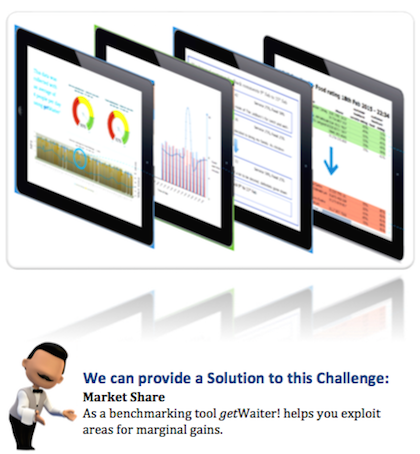In our previous article on Marginal Gains, we have briefly referred to Benchmarking as a reactive performance management tool that is normally rolled out across entire or specific sections of a restaurant chain. That however is not the exact textbook definition of the term.
The SlideShare piece on Hotel Benchmarking shared by John Sutton brilliantly communicates what Benchmarking is all about. We will therefore consider his presentation as a great starting point, providing a thorough definition of Benchmarking along with its aims and objectives.
Benchmarking within the Hospitality Industry
Whilst getWaiter! considers Benchmarking as an excellent opportunity; opposing reality still classifies the concept as a potential threat. Quite possibly the associated complexity of handling the exercise is what nauseates the restaurateurs. It may appear somewhat irrelevant to be investing money, allocating time, collecting data and employing an analytical expert to make the Benchmarking worthwhile whilst operating in a fast-paced environment.
That notion of an extensive preparation in aim to undertake a Benchmarking exercise is in most cases blown well out of proportion. With the right set of data and actionable reports, Benchmarking can soon become a threat to only those who do not take the full advantage of it.
Dear Restaurateurs, your regular sales feed statistics, are not going to cut it. You cannot find reasons for occurring dips and highlights with such information without diving into deeper investigations. Hence, it is time to open up your minds to new spectrum of unique possibilities.
Here at getWaiter! we believe that Benchmarking consists of a continuous measurement of performance between individual brands and between the brands of the entire restaurant or a pub chain. We consider it to be an essential exercise that increases Market Share as it helps to exploit areas for Marginal Gains.
We solely focus on providing customer experience based insightful and actionable data reports that you can use alongside your existing fiscal data. The combination of the two helps to identify venues within the chain that drive an exemplary operational excellence, and those which may require to follow their ‘role performance models’ to improve their current position within the chain.
Benchmarking: The Healthy Competition
As a Benchmarking tool getWaiter! helps to motivate directors, managers or waiters to develop a sense of internal competition. The depth of the data collected by our system effortlessly highlights areas for improvement alongside relevant metrics for Strategic Reward Systems.
Restaurant chains must have the opportunity to be trying out different things to attract and retain customers amongst the battlefield for Market Share. Having the right set of tools that will help to guide your restaurant chain through various tryout successes and failures will help you to catapult ahead of the competition. Our Help Guide to Benchmarking in Hospitality with getWaiter! will point you in the right direction for Incremental Performance Improvements, examples of which we will discuss later on this week.
Continuous Monitoring, controlling and responding to your real business performance will help you overcome challenges easier with only a small operational impact.

